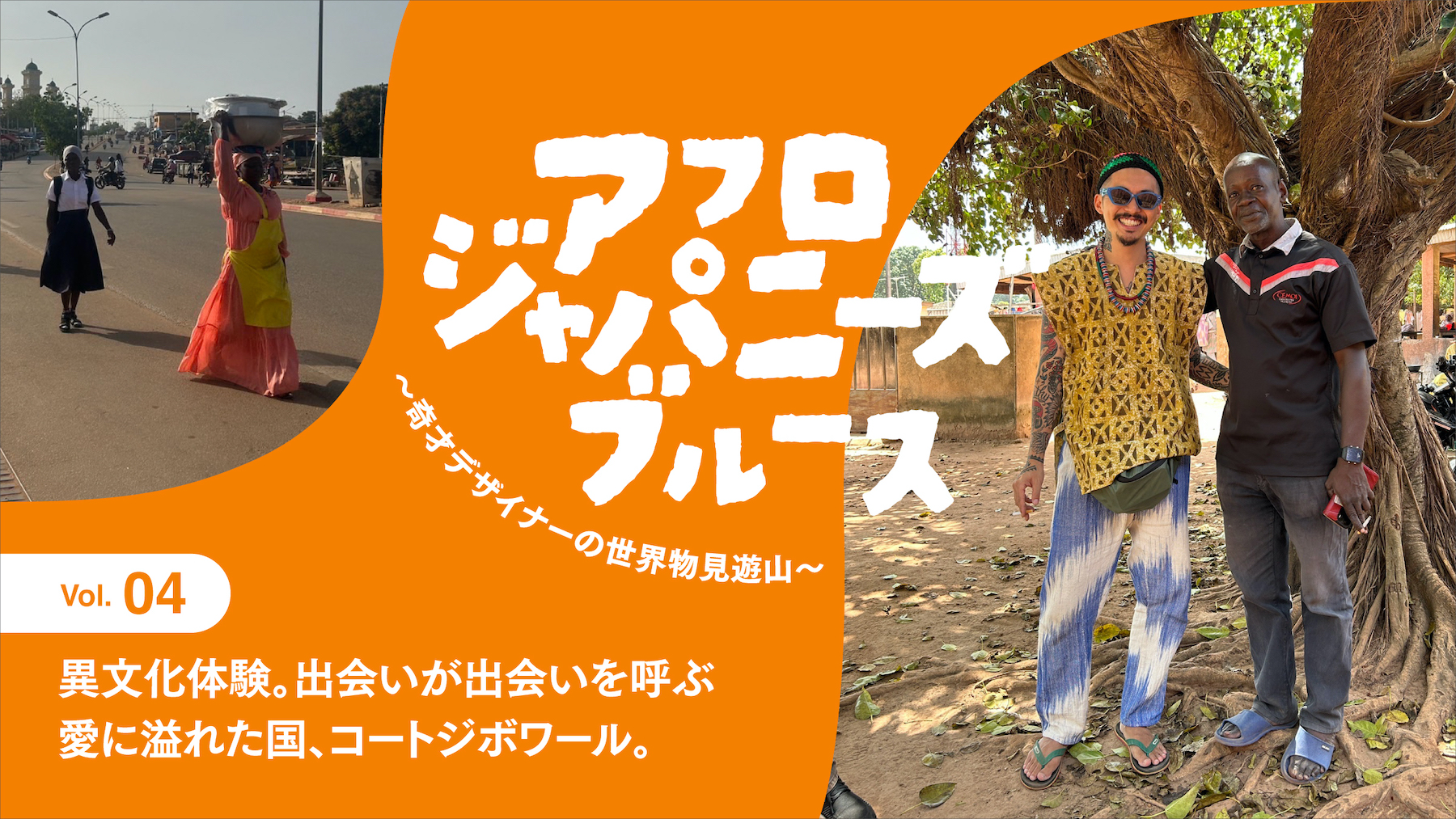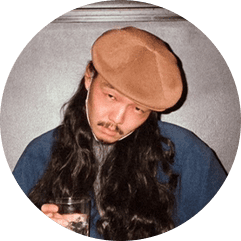Fascinated by black culture and passion forLamrofand an African jewelry label calledAFLOGICAL JEWELRYSDaisuke Sakamoto, aka Shirley, is a fashion designer who pours generously into the "Shirley" brand.
In addition, in recent years, the company has been developing a new label, "Miscellaneous Goods," which focuses on items from the American mid-century period, which it had been operating for some time.EARTHY ANTIQUESHe has also changed the direction of his business to mainly African goods, expressing the black culture he loves from various angles.
The term "Afro-zero" means "of African origin. In this sense, Sakamoto is an "Afro-Japanese" with roots in Africa, even though he is Japanese.
In this series, we introduce the people, things, and things that Mr. Sakamoto has seen while wandering around the world, especially in Africa, through his own filter. We present the realities of black culture as he sees it, how he incorporates it into his products, and the realities of the black culture that has fascinated him, through actual photos and Sakamoto's own voice.
Photo_Sha-Le (Daisuke Sakamoto)
Edit_Naoya Tsuneshige
PROFILE
In 2022, he launched the fashion brand "Ramroff". In 2024, he started an African jewelry label "AFLOGICAL JEWELRYS" and an antique goods label "EARTHY ANTIQUES". EARTHY ANTIQUES label will also be launched in 2024. He is deeply devoted to black culture and struggles daily to bring it to as many people as possible. He is also a soccer fan from the bottom of his heart.
Sha-Le Instagram:@8_shale_8
Lamrof Instagram:@lamrof_official
Aflogical Jewelrys Instagram:@aflogical_jewelrys
EARTHY ANTIQUES Instagram:@earthy_antiques
Buying with your feet is an ironclad rule of buying....
last timeThis is a report on his wanderings in Cote d'Ivoire, following on from the first article in this series. On this day, Mr. Sakamoto headed for Bouaké, located further north from the capital Yamoussoukro. He went to the birthplace of the "pre-prepared masks" that inspired him to collect masks.
A pre-prepared mask that Sakamoto actually bought.
Here in Buaque there is a tribe of people called the Baure. The Baure have many different kinds of masks, all of which are unique. I am particularly fond of a mask called a "pre-pre-pre," and I keep buying them whenever I find them in various places in Africa. They are also famous for being used by jazz pianist Herbie Hancock on the cover of "Watermelon Man. I have always wanted to experience the culture of the Baure in person, and now my dream has finally come true.
At this point, however, Sakamoto had already made his next appointment. He only had about five hours left before his departure. Although he had limited time, he was able to make a satisfactory purchase through his specialty of asking around and gathering information.
I was about to give up when I asked a few people," he said. Most of them said, 'There is no place like a big antique market. Just as I was thinking that I might not be lucky this time, miraculously I met someone who had a connection with a dealer, and he suggested a plan to visit the dealer's private home. As usual, I am lucky, or blessed with good people..."
I was immediately taken on a ride on the back of a motocross bike to a total of four dealers' homes, all of which were ordinary private homes in Africa. All of them were ordinary African private homes, so when someone like me visited there, the children were amused and gathered around. I think it must be really rare to see Japanese people in Cote d'Ivoire. I was able to buy several masks of excellent workmanship and design, and both the dealer and I were very satisfied with them.
One would think that he would be satisfied with his purchases and take the rest of the day off, but the amazing thing about Sakamoto is that he is still stoically continuing with his purchases.
I thought that since they were mainly a mask dealer, their other items might be weak, so I asked, "I'm looking for jewelry, too. I asked him if he had any jewelry, and he said, 'There's one guy who is a badass. I was again reminded that I am truly blessed with good people. The place he took me to was a very local area that I would never have been able to reach by myself. There was a small prefab hut there, and when I was told the venue was here, I honestly thought I had missed the boat.
When I unlocked the door and entered the shop, I was amazed to see an impressive array of African beads. In fact, he was a famous dealer who mainly distributes beads to dealers all over Ivory Coast. It's encounters like this that make it hard to stop. I am afraid of Buaquet. Although it was unexpected, we were able to buy a large quantity here as well, and we ended our buying in Bouake with great satisfaction."
Meet the father you can count on.
After a very satisfying Buaquet purchase, Sakamoto moved further to Korgo, a town on the Burkina Faso border, to start his purchase later that day. Korgo is a town where many of the Senufos people, who created the popular Senufos tool in Japan, live. So what kind of encounters awaited Mr. Sakamoto, who could not help but have high expectations.
Korgo is quite rural compared to Abidjan, but there are still many people. And they are all basically Senufo people. I started asking around to see if I could find some folk crafts, mainly stools, and I ended up in one area. I ended up buying a mask from one of the few non-Senufo tribes (laughs). (laughs).
I was looking at Google Maps and found a place that looked like it, so I decided to take a motorcycle cab there. My hunch was right. When we were led into the room, we were greeted with a wide array of special pieces. It seems to be the collection of Mr. Sulaiman, who lives there, and there are eight rooms with this level of items. I was so excited all the time. Since it was already night at this next point, we promised to definitely come back the next day, and we disbanded for the day with our excitement unabated."
The next day, Mr. Sakamoto immediately visited Mr. Slimane's collection house. It seems that he had a warm time, not just buying, but also getting in touch with the personality of the Ivory Coast people.
We arrived at the collection house with all the excitement of last night intact. Perhaps sensing that it was going to be a long day, they served us lunch and coffee on the way and told us all about the antique masks, as well as about Korgo and Cote d'Ivoire. I told him that my main job is a fashion designer and that I am looking for African jewelry and traditional costumes as well as African folk crafts. I am so blessed. It's almost a miracle."
Sulaiman gave me a part of his valuable collection that day, dropped me off at my hotel, and left, telling me he would come back to pick me up at 7:00 the next morning. I wonder if this is the same all over the world... I feel that the more you go to the countryside, the more kind people there are. Maybe Mr. Sulaiman is just an anomaly."
This is the first time a Japanese person has experienced this...?
Most people, especially if they are going abroad for the first time, do a lot of preliminary research and have a clear idea of their objectives and means of transportation before they go anywhere. However, Mr. Sakamoto values the live and firsthand experience, and with his natural friendliness, he goes to new places one after another. On this particular day, he was accompanied by Mr. Sulaiman, with whom he had developed a relationship the day before, to a more rural village.
Sriman picked us up early in the morning by car and we drove for about an hour on a rutted off-road road. We arrived at a village called Waraiene. This is a village where all jewelry is made by traditional methods using only natural materials. I remember how interesting it was to be shown the entire process from start to finish, something I had never seen in any other town I had visited."
Jewelry by Waraiene made only from natural materials. The photo shows a necklace actually purchased by Mr. Sakamoto.
Next, Sulaiman took us to the village of Capella, which is known for its traditional sewing techniques. This place was also really amazing..."
After greeting the village head, I was shown around the village and learned that about 100 people work here and that everything from thread to fabric, from dyeing to sewing is done in this village. I was told that all kinds of ethnic costumes of the Senufo people are made here and distributed throughout the Ivory Coast.
I had always loved the folk costumes of the Senufo people and was really looking forward to this day. Perhaps it was because I wore the full Senufo costume out of respect that the village chief liked me so much that he allowed me to actually weave the fabric by hand.
It is decided that Senufo fabrics are only to be made in 50cm widths, and 50cm widths of fabric woven from yarn are joined together to make one large piece of fabric. It seems that this process is done by sharing the workload. I was allowed to experience one of the processes. I am so grateful that they let a Japanese person, who I don't even know where he comes from, do such a traditional thing. I spent my precious time thinking about how I could incorporate this into the Ramroff collection. At the end of the visit, the village chief presented us with a traditional costume and fabrics of the Senufo people. I left the village feeling grateful beyond expression. It was a great experience."
It was the last two days of our intense trip to Cote d'Ivoire. It seems that they were in a flurry of activity right up to the end, from the 10-hour crammed bus ride back to Abidjan to applying to the museum in Abidjan that is required to take folk art out of Cote d'Ivoire.
He said, "Traveling by bus is really tough, but this is part of traveling in Africa. Sulaiman was very helpful to us until the very end, and even in Abidjan he introduced us to a certain dealer who allowed us to purchase a few special pieces at a furious rate. Moreover, that person offered to do the troublesome application to the museum for me, which was really helpful. It has been the same in the past, but in the second half of the Ivory Coast, I was especially blessed with people.
Finally, he reflected on Ivory Coast.
It has truly become one of my favorite countries. The people have a strong spirit of self-sacrifice, there is a perfect hybrid of urban and local elements, and the local food is just delicious, especially the achake. The biggest difference between Cote d'Ivoire and other countries in terms of folk art is that most dealers deal only in their own folk art (in other countries, many dealers collect folk art from various African countries), and I felt that dealers in Cote d'Ivoire are proud of their own culture. And they were all of special quality. I will surely come back next year. Merci beaucoup, Cote d'Ivoire!"
Sha-Le:@8_shale_8
Lamrof:@lamrof_official
Aflogical Jewelrys:@aflogical_jewelrys
EARTHY ANTIQUES:@earthy_antiques










